Bruges Sightseeing Bike Tour
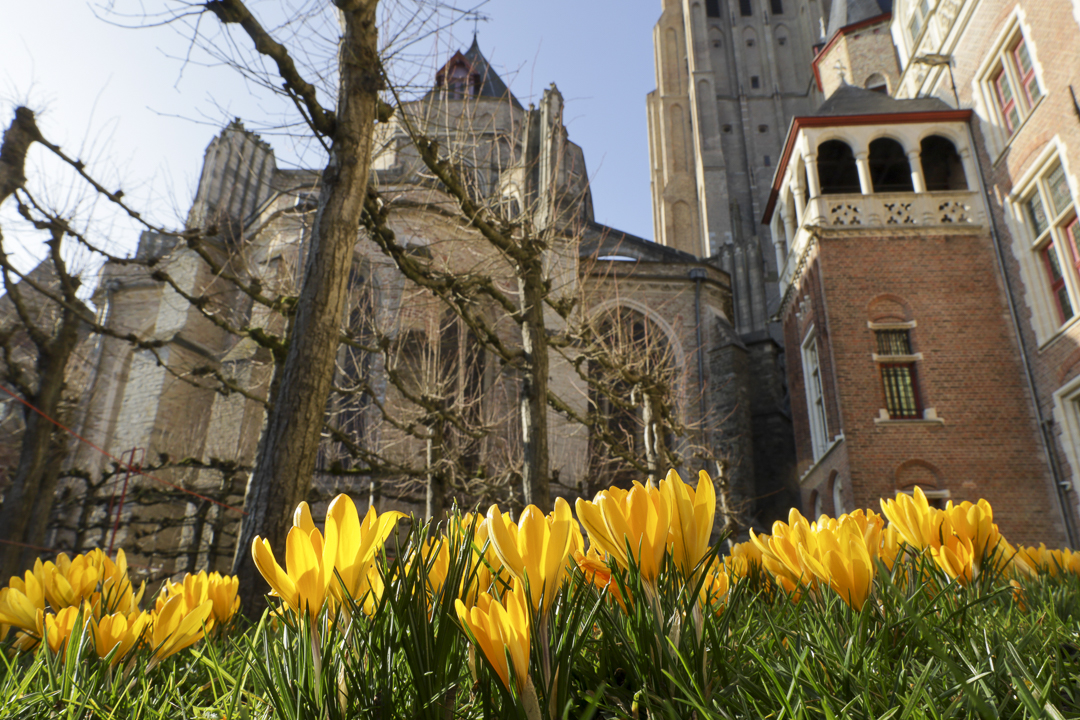
A bike tour in Belgium’s medieval wonderland Bruges
One of our favorite dates every year is the annual Cycle Cities Symposium happening in February. We get together with other like-minded bike tour enthusiasts who run businesses like ours in cities all over Europe and by now even in the States, South America and Africa. After getting together in Munich, Athens and Tallinn in the past several years, this was the first time after Covid that we were able to meet again with lots of people, 40 people from 25 (!) cities to be exact.
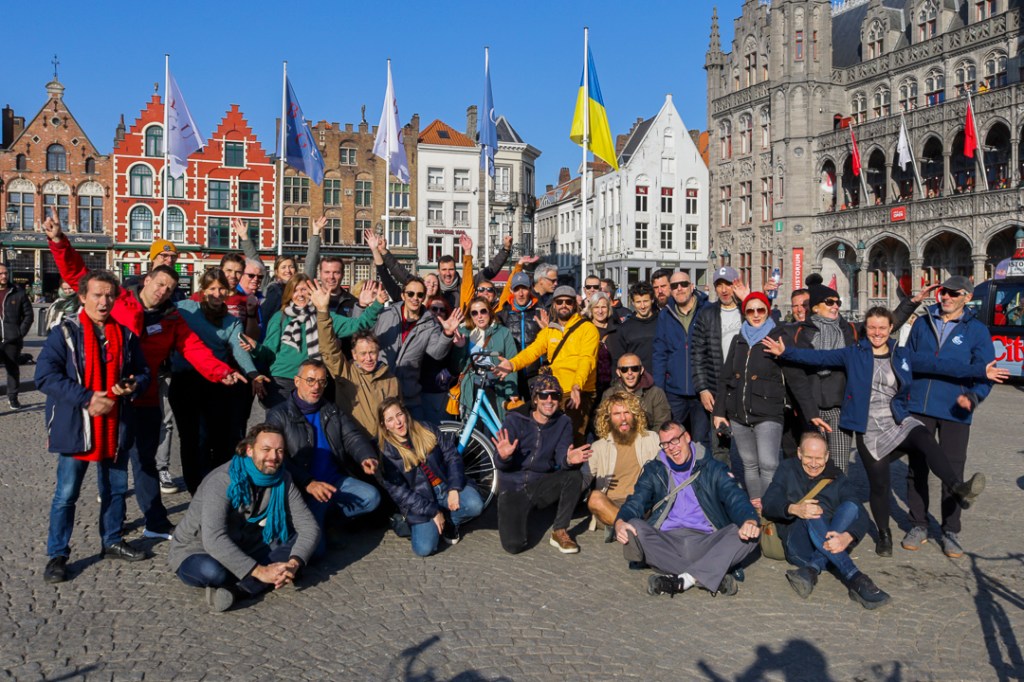
Bike tour operators looking forward to a bike tour on the main square in Bruges.
And as we wanted to celebrate this in style, we did not only explore one city by bike this time but three! How is this possible in a mere 6 days? We went to Belgium, which offers great cities, lots of history and is super bike-friendly – that means we have 3 partner cities that are at most 1 hour by train apart – Bruges, Antwerp and Gent and if you cannot get enough of cycling in Belgium, you can also join a tour in Mechelen.
In Bruges our host was Quasimundo whose headquarter is only 5 minutes away from Bruges’ central square. Quasimundo started running bike tours in Bruges in 2001, so after more than 20 years they clearly know what they are doing.
Cycling Bruges
Cycling in Bruges is very easy as there are lots of cycle paths and there are very few cars in the old town. With its charming historical city center Bruges is one of Belgium’s most popular tourist spots, before Covid 8 million guests visited the city that only has 120.000 inhabitants in total and 20.000 in its historical center. After our first walks around town and our bike tour we got a good idea why it’s so popular.
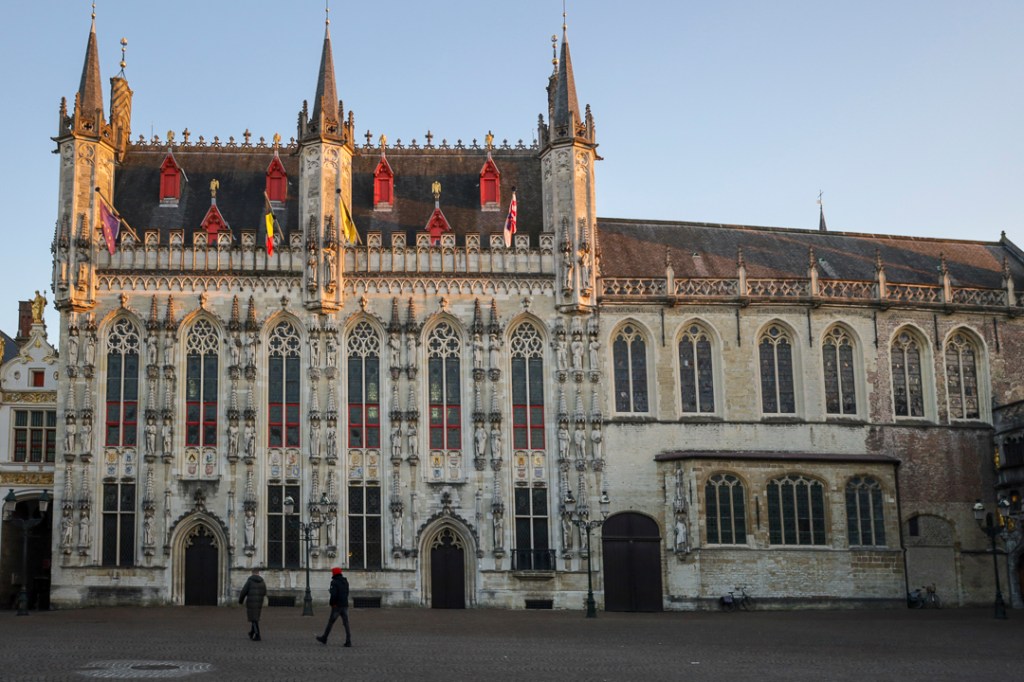
Neo-Gothic town Hall on the Burg Square in Bruges
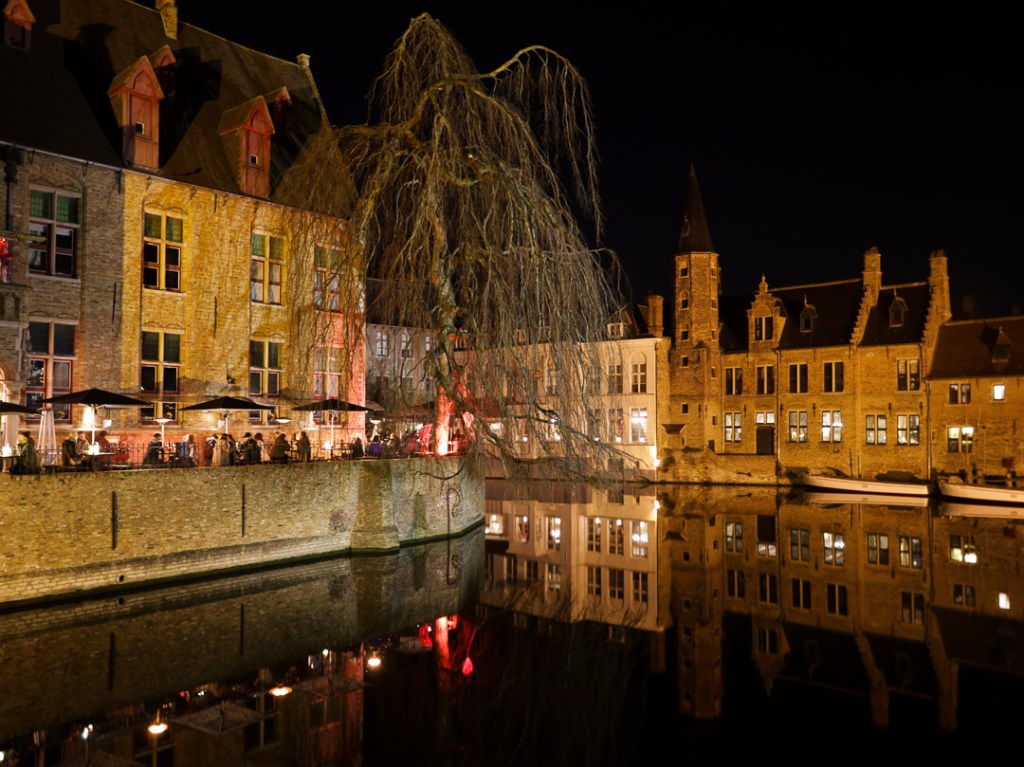
How picturesque can a city be, seriously?
When coming from Berlin with its many very visible scars a completely intact medieval city like Bruges seems like a miracle. Our fun and knowledgeable guide Dany first took us along some of Bruges’ beautiful canals that are lined with brick houses in the Neo-Gothic style.
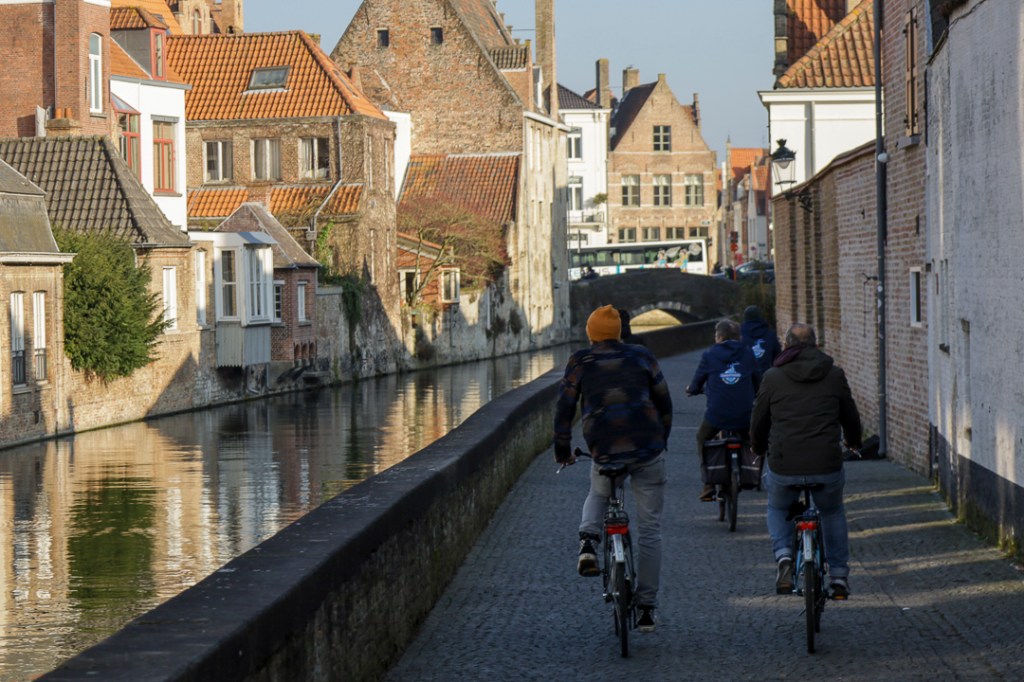
Cycling along the canals, just because they are so beautiful.
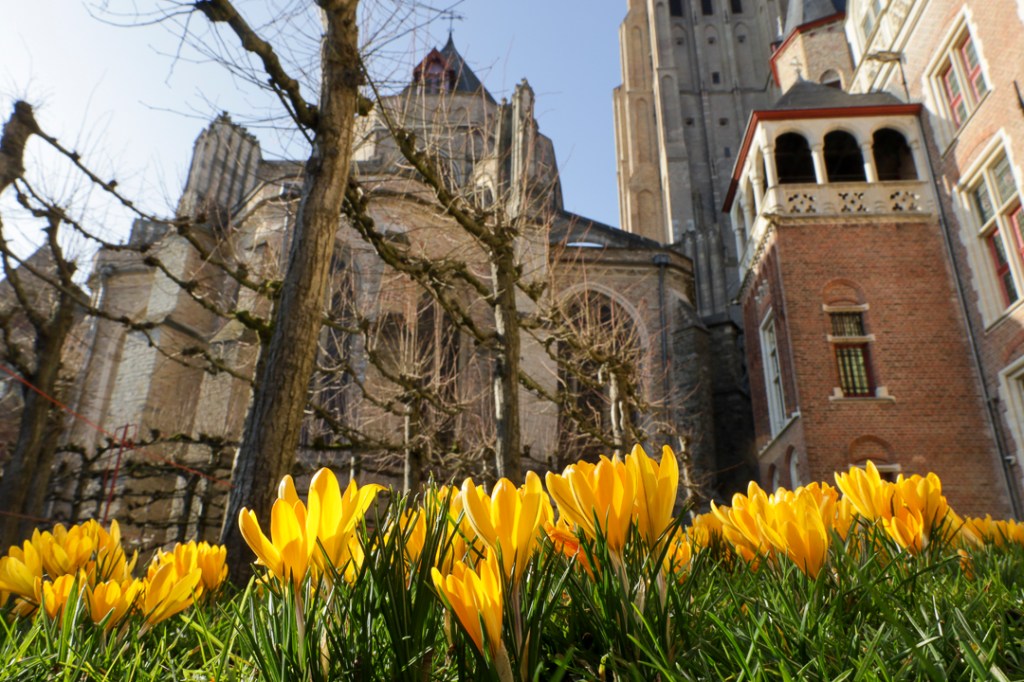
I don’t remember the name of this church but it’s so pretty with the flowers.
Bruges’ Golden Times
Although Bruges historical center is fairly small you can see and sense at every corner how rich and important it must have been centuries ago. Canals run in and around Bruges everywhere. They were the foundation of Bruges’ success as one of the most important trade centers in the Middle Ages. From 1100 to 1450 next to Venice Bruges was the richest city in the then known Western world thanks to its location just 15 kilometers from the North Sea and easy access to France, the Netherlands, Germany and England. Under the patronage of the counts of Flanders, rich merchants from all over Europe came here to trade their goods and ship them on to other places. This was an early capitalist mekka, so it’s only logical that a financial innovation we still know today has its origin here. In 1309 the Bourse opened, most likely the first stock exchange in the world (the German word for stock exchange is “Börse” so that hasn’t changed a bit). After Bruges’ golden century in the 15th century with business booming like never before, its luck had to change eventually. At the end of the 15th century two developments led to Bruges’ speedy decline: the city got into trouble with its new ruler Emperor Maximilian of Austria and lost its access to the sea when the Zwin channel silted up. After this Antwerp snatched away Bruges’ crown as Flanders’ most important port.

Bruges’ former harbor at Jan van Eyck Square. Hard to imagine how busy this must have been once with ships from all over the world being loaded and unloaded.
Exploring Bruges’ sights by bike
We set off on our tour starting with Bruges’ historical fish market (Vismarkt). Here right next to a canal that leads to the North Sea in one direction and Gent in the other Bruges’ citizens could buy fresh North Sea fish in a colonnade inspired by Roman temples built at the beginning of the 19th century.
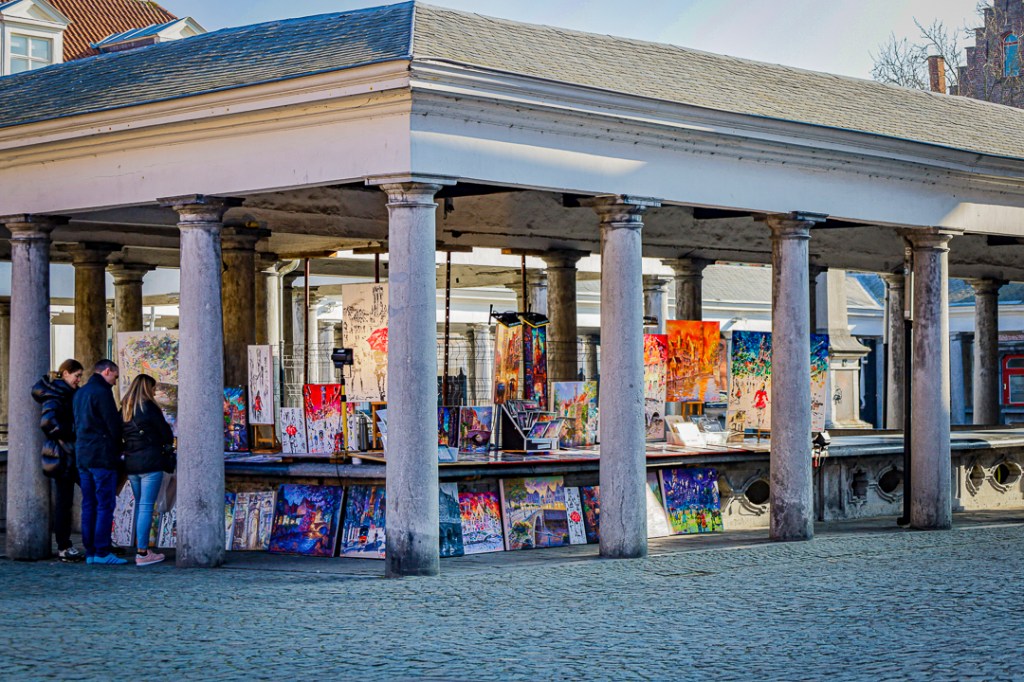
Looks almost too fancy to sell fish here, so now they sell art at Bruges’ fish market. From Wednesday till Saturday you can still get fish here though
We continue cycling along canals lined by beautiful houses and Dany explains that these used to be prime real estate during Bruges’ heyday as a trade city. Rich merchants wanted to live right next to the canals because their goods were unloaded directly from ships into their houses’ basements. Apart from being the city’s trade routes the many canals were also a part of Bruges’ fortifications together with the seven city gates.
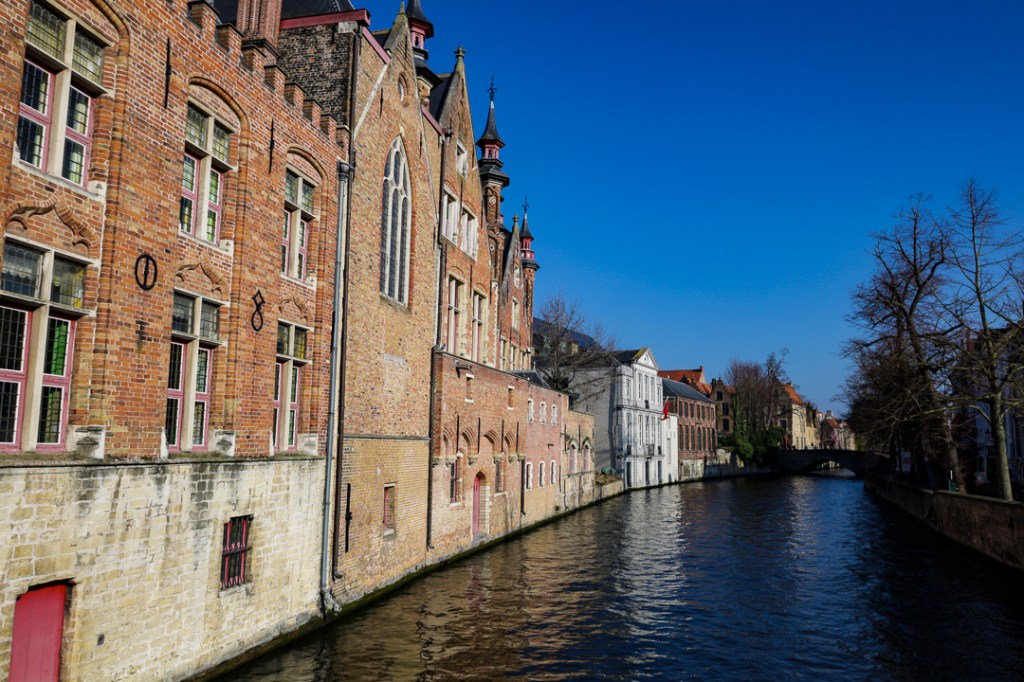
Here you can see that these buildings have doors at water level so goods could be unloaded directly from the ships into the basements.
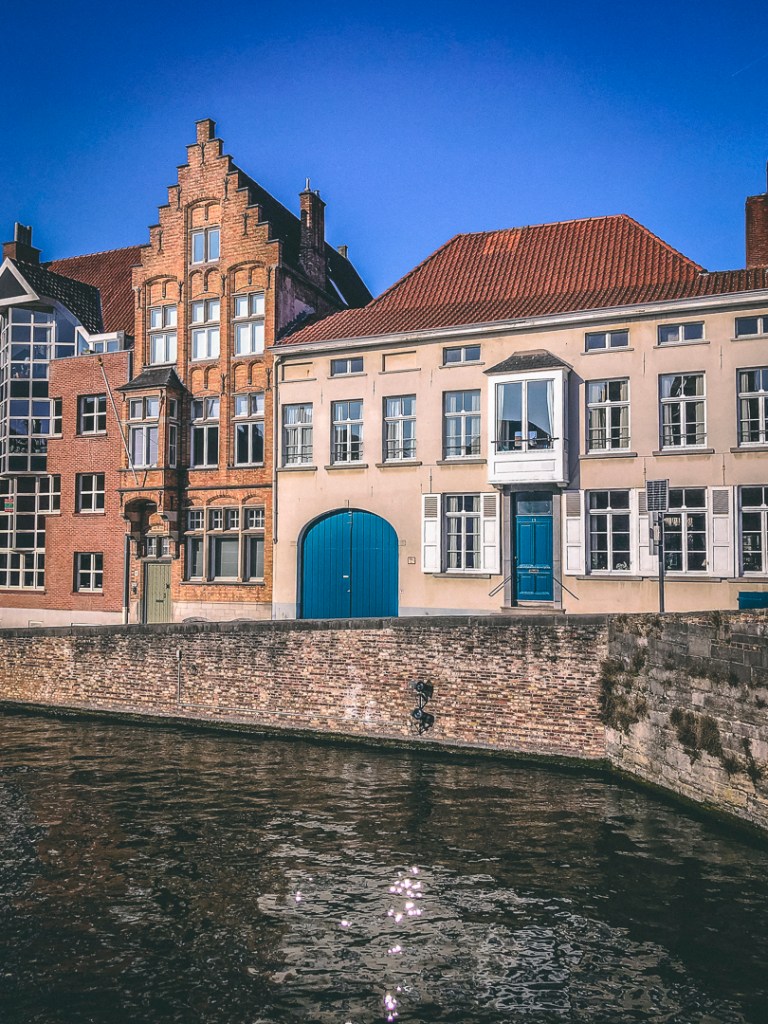
Beautiful buildings everywhere in Bruges but especially along the canals.
Next we get to Jan van Eyck Square, which used to be the site of Bruges’ bustling harbor. Traders from all over Europe lived and worked here and each group had their own representative quarters, merchants from England, Scotland, France, Germany, the biggest Italian community outside Italy, the Basque country and all the way to the Baltic. With these riches Bruges also reached its artistic peak, with the so-called Flemish primitives, among the first artists to popularize oil painting. One of its most important representatives Jan van Eyck got its own monument here and is towering over the old port basin.
We continue on our bikes to Bruges’ oldest pub, the Vlissinghe and the Jerusalem Church until we reach the outer edge of the medieval city. Here you can cycle along four wind mills, out of originally 23, that were once a part of the old city ramparts. We take a little break and Dany surprises us with a liquor traditional in the Netherlands and Belgium, Jenever, that is distilled from juniper berries.

One of only two authentic wooden facades in Bruges that have survived over the centuries. From the 17th century onwards wooden buildings were forbidden because there were just too many fires.
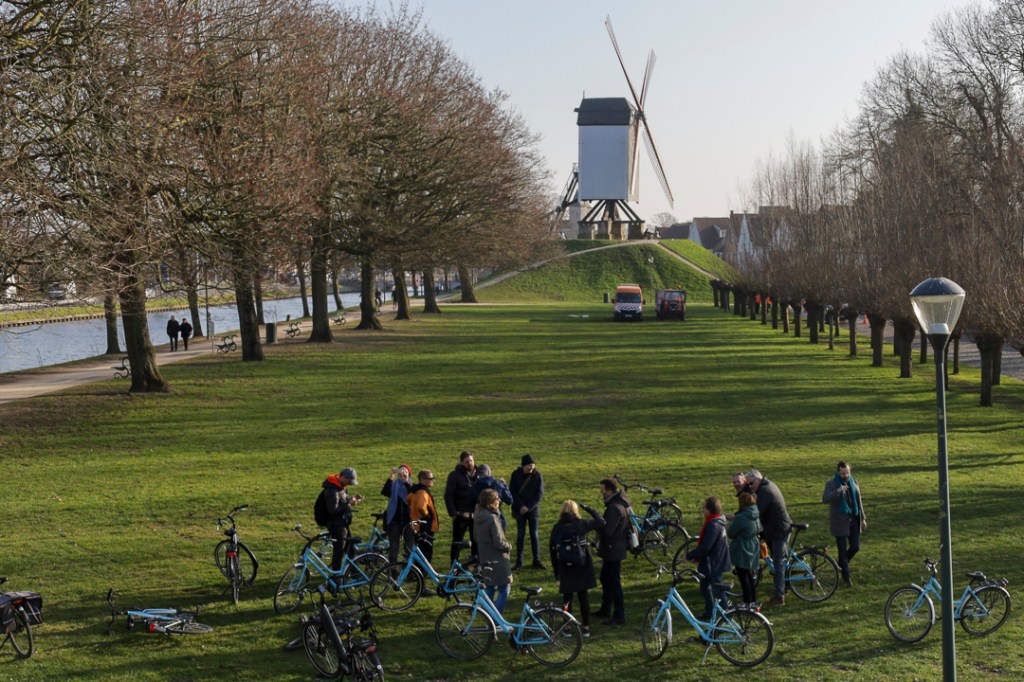
Time for a stop at one of Bruges reconstructed wind mills. One of them is still operational.
Our tour takes us further around the old city boundaries that you can cycle along on bike paths right next to the canal. We reach some more scenic spots like the Minnewater (“Lake of Love”) which is very popular for romantic selfies with your sweetheart – sorry if we are soppy but we came here on Valentine’s Day.
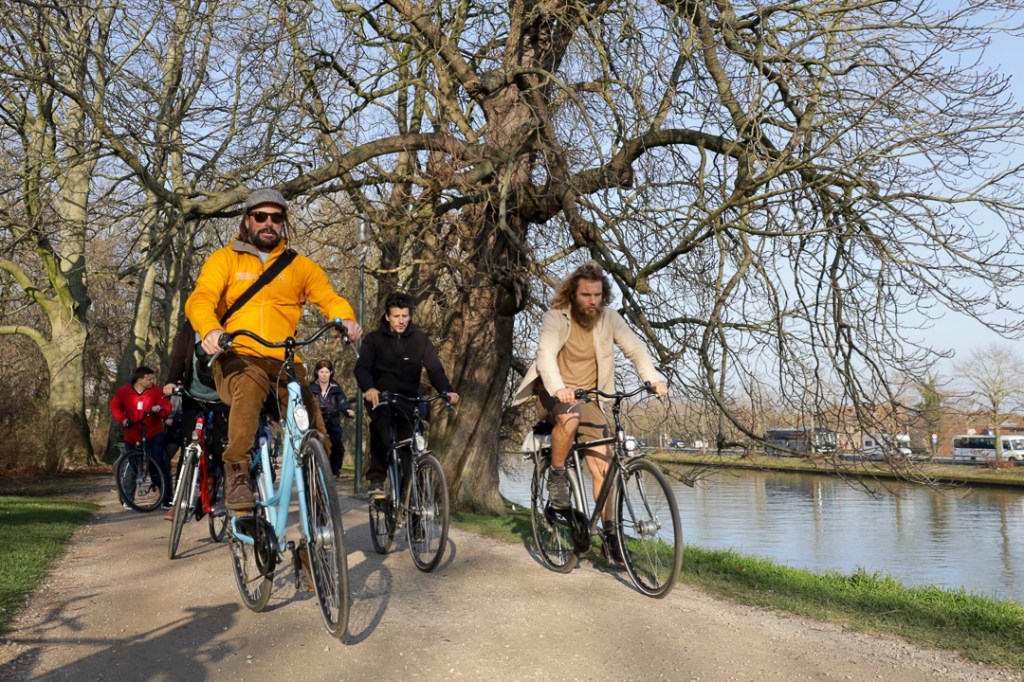
Cycling along the canal in Bruges is great fun.
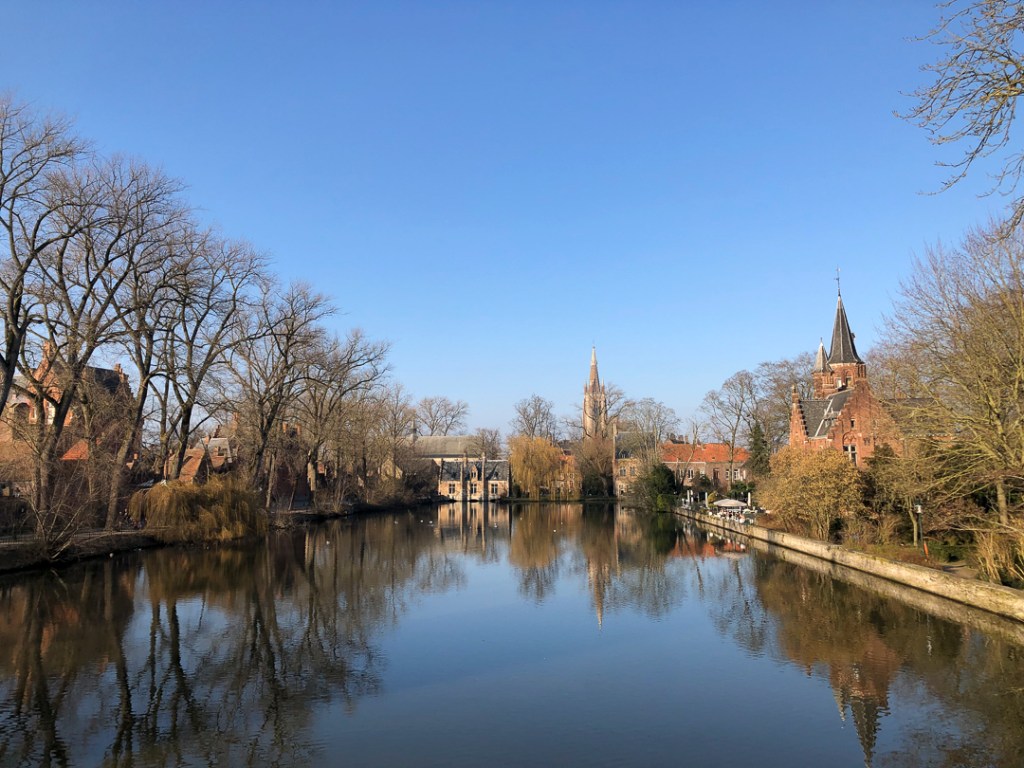
This romantic hotspot is called Minnewater. Dany told us so many stories about its name’s origins but they just didn’t stick.
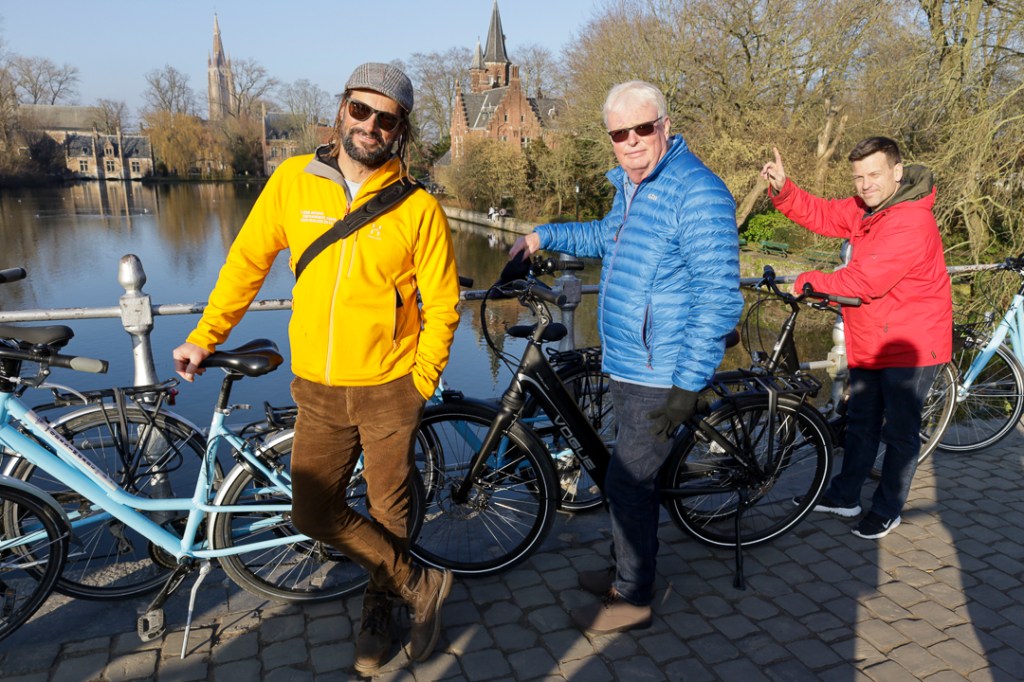
We were pretty lucky with the weather for our bike tour and Rupert, Rob and Peter dressed perfectly.
Our next to last stop was the beautiful Begijnhof Ten Wijngaerde whose courtyard is a tranquil oasis in the inner city. Here starting in the 13th century single women started living together in a community that closely resembled a convent. The beguines however did not take vows like nuns did and were free to leave at any time. They lived a pious and celibate life, reading, teaching and caring for the poor and our guide Dany portrayed them vividly as being one of the first emancipated women in the world.
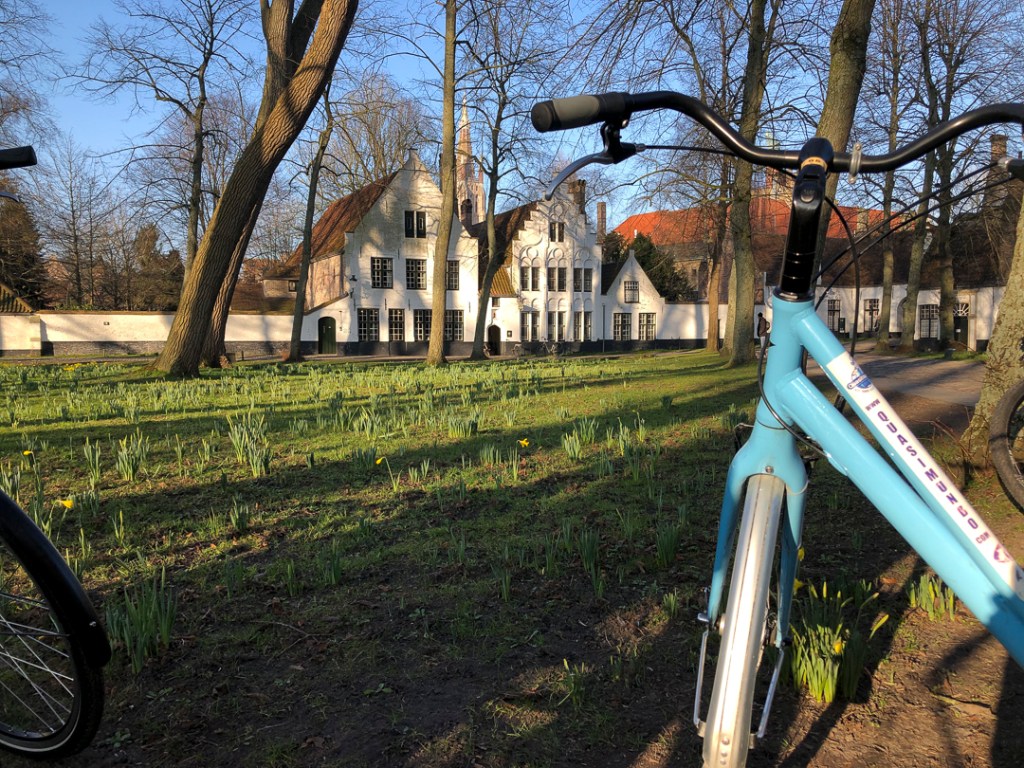
The Begijnhof is a tranquil oases in the city.
Our tour ended the only way possible in Belgium in the local brewery ‘De Halve Maan’ that operates from a beautiful historical complex. Here we tasted the city’s famous Brugse Zot, a strong, high-fermentation beer, wishing that beer was still being brewed in our own headquarter in Berlin in the Kulturbrauerei.
If you ever visit Bruges, pay our friends from Quasimundo Bike Tours a visit and take one of their tours. We promise you will not regret it.
Contact Info Quasimundo Bike Tours
Predikherenstraat 28
8000 Brugge – Belgium
E-mail: [email protected]
Phone: +32(0)50 330 775 or +32(0)50 670 483
Standard tours take 2.5 hours and cost 33 € for adults, 27 € for students & 15 € for 6 to 12 year olds.
Fotos: Martin Riewestahl & Judith Seidel
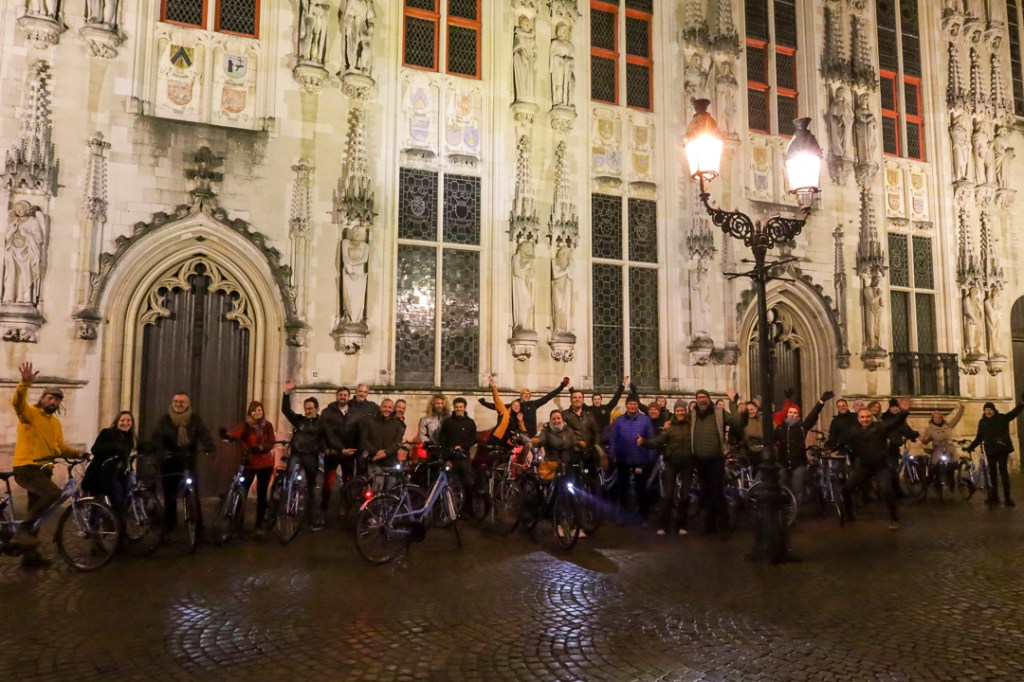
We went on another tour at night just because we could.

